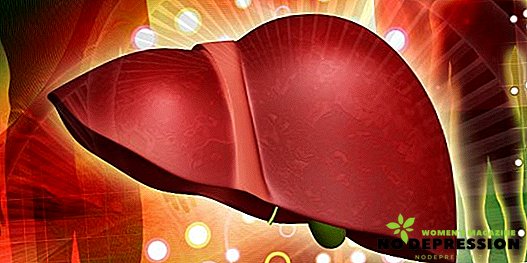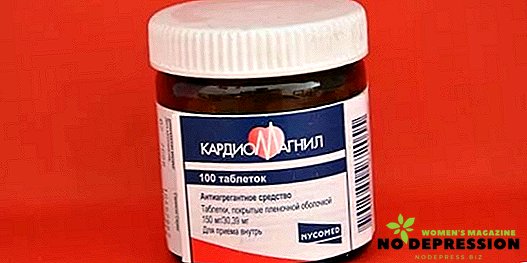Fatty hepatosis is a disease in which liver cells are transformed into fat cells. At the chemical level, this process consists of the accumulation in the liver cells (hepatocytes) of simple fats (triglycerides).

Let us consider in more detail the causes provoking the emergence and development of the disease.
- Diabetes mellitus, obesity, hypertriglyceridemia - diseases that lead to a violation of lipid metabolism in the liver cells. The only option to avoid the improper metabolism of fats with such diagnoses is to follow a strict diet, in which the smallest possible amount of them will be ingested.
- Toxic poisoning of liver cells. In the role of toxic substances here can be, for example, alcohol. The body, filtering its entry into the body, eventually ceases to cope with its function, the result is fatty hepatosis.
- Excess Radiation Indicators.
- Improper diet, leading to a violation of the metabolism of fat. Here it is meant both the eating of harmful products containing a lot of fat and carbohydrates and little protein, as well as constant exhausting diets in which the body ceases to fulfill its intended purpose.
- Diseases of the gastrointestinal tract, leading to indigestion.
- The course of taking antibiotics without using after probiotic preparations.
- Diseases of the thyroid gland.
Symptoms of fatty liver
The insidiousness of the disease lies in the fact that for a long time it may not manifest itself, and it is usually detected by chance during ultrasound examination or screening of completely different organs.
Symptoms at different stages of hepatosis are radically different from each other. The most frequent clinical manifestations of primary and first-degree liver hepatosis are:
- changes in test results (liver enzymes).
The first stage is characterized by the presence of an inflammatory process, leading to the degeneration of liver cells into cancer or the development of cirrhosis.

The second degree of hepatosis is accompanied by:
- pain under right ribs;
- unpleasant feeling in the stomach, closer to the right side;
- enlarged liver, which can be felt with palpation;
- ultrasound reveals an altered state of the liver;
- decreases blood flow in the liver cells.
The third degree of hepatosis has the following symptoms:
- nausea;
- constant aching pain in the abdomen on the right side or in the right side under the ribs, which prevent a person from living a normal life;
- constipation or, conversely, severe flatulence;
- violation of the digestive process.
Diagnosis of fatty liver
Diagnosis is carried out only after a series of measures taken:
- examination of the patient and palpation of the liver;
- ultrasound procedure;
- tests for determining the number of liver enzymes and comparing them with the norm;
- liver angiography.
It is important to bear in mind that hepatosis of the liver can only be a consequence of the development of some other disease, for example, hepatitis or cirrhosis.
What is the treatment
 A doctor may treat a patient with a diagnosis of hepatosis of the liver, both in a hospital and on an outpatient basis. The main direction of work is the preparation of a competent diet and its strict observance over a long period of time. In this case, the food should be supplied with the minimum amount of animal fat, and protein - not less than 110 g per day.
A doctor may treat a patient with a diagnosis of hepatosis of the liver, both in a hospital and on an outpatient basis. The main direction of work is the preparation of a competent diet and its strict observance over a long period of time. In this case, the food should be supplied with the minimum amount of animal fat, and protein - not less than 110 g per day.
To speed up the healing process, lipotropic preparations, vitamins of groups B, lipoic acid are prescribed. An important method of getting rid of impaired fat metabolism is to lose excess body weight.
So the loss of 5 to 10% of the mass immediately leads to the normalization of the patient's condition. With the disease also shows physical activity.
The basic rule that allows you to recover from the fatty hepatosis of the liver, is to find and eliminate the cause of its occurrence.
If the reason for the emergence and development of hepatosis was excessive alcohol consumption, then it would be logical to undergo a course of treatment with a narcologist.
Drug treatment of fatty liver hepatosis: drugs and drugs
A patient on a diet, exercising and taking medication has a good chance of getting rid of fatty liver hepatosis. Support of the body with the help of medicines is aimed at eliminating the causes of obesity, as well as at accelerating the natural processes of regeneration of liver cells and their regeneration.
Usually for the treatment of the disease using drugs of three groups of orientation:
- Essential phospholipids - protect liver cells (hepatocytes) from adverse effects and death, promote natural cleansing of the liver from accumulated fat deposits. Drugs of this group stimulate the process of outflow of bile, do not allow the liver tissue to degenerate into fat;
- sulfo-amino acids - reduce the rate of oxidative reactions in the liver, protect its cells;
- herbal remedies are aimed at diluting the bile, its speedy withdrawal from the organ. They relieve such symptoms of hepatosis as a feeling of heaviness, pain.
Drug treatment should be prescribed only by the supervising physician, act in the system along with the strictest diet.
Treatment of fatty liver hepatosis folk remedies
Folk remedies for the treatment of hepatosis of the liver are aimed at accelerating the process of removing excess fat from the body and the liver in particular. Consider a few effective recipes and rules of alternative medicine. It is important to remember that any method should be pre-negotiated with your doctor.
- Mint leaves and melissa, added to tea for breakfast, normalize the process of burning fat.
- In the early stages of hepatosis, pine nuts will have a good supporting effect on the liver cells. Enough to eat 1 teaspoon per day.
- Rosehips weighing 50 g brew 0.5 liters of boiling water and leave to infuse for about 10 hours. The frequency of taking the decoction - 4 times a day, one glass.
- An infusion of 20 g of mint and 0.5 cups of boiling water, infused for 12 hours, is drunk 3 times a day.
- Carrot juice promotes speedy recovery. It is recommended to drink half a glass of fresh juice on an empty stomach per day.
- Fresh dill, lettuce and parsley help speed up the process of splitting fats and remove them from the body.
- Green tea is a good means of promoting the elimination of toxins, slags, accumulated harmful substances and fats from the body. It is enough to drink 3 cups of tea per day to cleanse the body, including the liver from their negative effects.

If hepatosis of the liver has led to an increase in its size, then you should pay attention to the following recipes of traditional medicine to normalize its condition.
- Infusion of fresh lemons. To prepare it, 3 lemons are crushed into a mush, pour 0.5 liters of boiling water and allow to infuse for 12 hours. The entire volume must be consumed in the day between meals. Lemon infusion regimen: 3 days in a row, then a break of 4 days is observed.
- To help the liver to return its previous size will help dried fruits, which help accelerate the process of burning fat. A day is enough to use 30 g of dried fruit.
Diet for fatty hepatosis of the liver
The diet prescribed for hepatosis of the liver helps to regulate the performance of impaired functions, normalize the process of burning and excretion of fats, cholesterol, and improve the production of bile that is involved in the process of digesting food.
In the diagnosis of impaired fat metabolism, there is a clear distribution of the amount of consumed fat, carbohydrates and proteins. So the caloric content of food eaten per day should not exceed 3300 kcal, including carbohydrates - no more than 400 g, fat - no more than 80 g, proteins - no more than 140 g. Preference should be given to vegetable fats.
There are the following basic principles of the diet for hepatosis of the liver:
- The multiplicity of meals should be 5-6.
- Stop drinking alcohol, which only increases the load on the affected organ.
- Per day drink at least 1.5 liters of fluid. Water contributes to the rapid breakdown of fats and harmful substances and their removal from the body.
- Eliminate excessive salt intake, which retains water in the body.
- Protein is needed to bring fat metabolism back to normal.
- It is important to monitor the temperature of food intake. It should not be too hot or cold, as it adversely affects the process of digestion.
- It is necessary to get rid of excess weight, inhibiting the flow of metabolic processes in the body.
- Do not eat fried, spicy, as well as products with a high content of animal fat and easily digestible carbohydrates.
Complications and consequences of the disease
Fatty hepatosis of the liver is dangerous because in the absence of proper medical treatment, adherence to the strictest diet, it causes the development of the following diseases:
- development of bleeding, including internal, dangerous risk of a lethal outcome;
- hepatitis;
- cirrhosis, in which there are irreversible changes in the structure of the tissue of the body, leading to death;
- liver failure;
- hepatic coma.

Prevention of the onset and development of the disease
The main prevention of the onset and development of fatty hepatosis is to adhere to a healthy lifestyle, proper nutrition, giving up bad habits (smoking, drinking alcohol), tracking one's weight and maintaining it at a healthy level.
Among the preventive measures for the development of the disease are:
- If hepatosis manifested itself in its hereditary form, then a diet and well-distributed physical activity will help reduce the risk of seasonal exacerbation.
- Exclusion of uncontrolled intake of any medication that has a toxic effect on liver cells.
- Compliance with the rules of healthy eating, including eating high-fiber foods.
- Refusal of spicy, too cold or hot foods, fried and canned.
- The elimination of alcohol and smoking.
Finding the right treatment, prescribe medications, can make a diet only the attending physician after a comprehensive examination of the body and laboratory tests. The prognosis for this disease is favorable only in the case of full compliance with all prescriptions of the doctor. If you have any problems with the liver, you should immediately seek advice from a hepatologist and endocrinologist.
Additional information about fatty hepatosis of the liver can be found in the following video.












